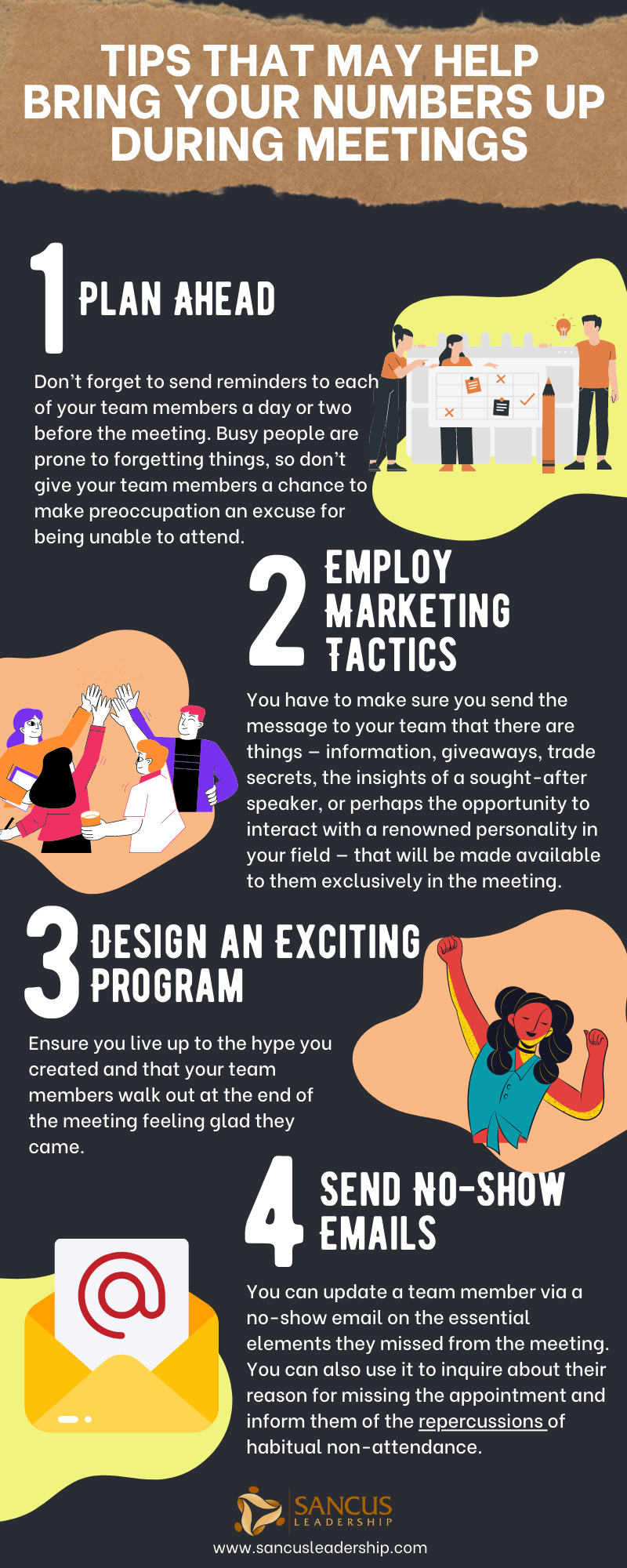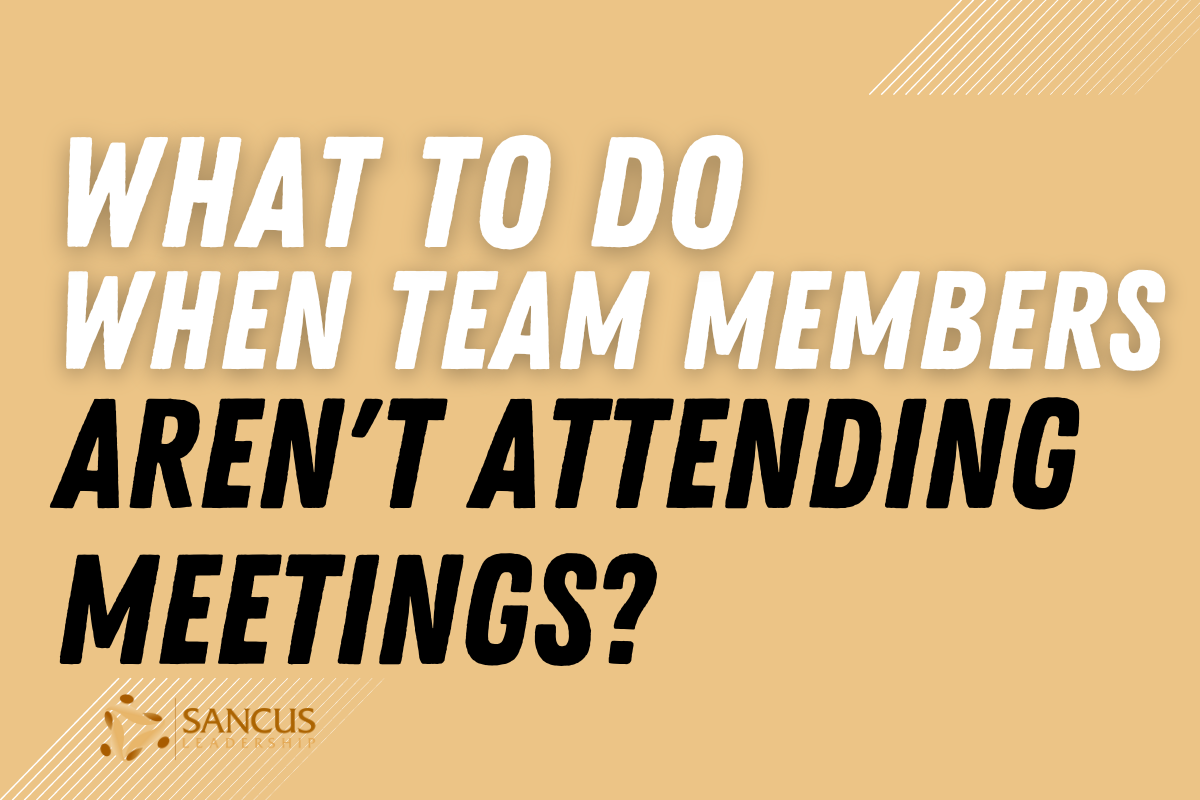Remember the good ol’ days when you would announce the date of the next meeting, and everyone would show up, and that’s that? These days, setting appointments with your team seems like such a chore because everyone’s always busy, and their schedules are always packed. If you’re starting to feel like you always have to compete for your team’s attention, you’re not alone because many leaders find themselves in this predicament.
When your team members aren’t attending meetings, consider distributing flyers and putting up posters to attract attention and highlight the exciting things that await them. Always start on time and stick to the plan so busy schedules aren’t disrupted. Send no-show emails to habitual offenders.
Always start on time and stick to the plan so busy schedules aren’t disrupted.
Stick around to gather tips on dealing with team members who aren’t attending meetings, especially when noticing that this is becoming a habit. Please find out how marketing your appointments to your team can make a difference in their excitement to participate and how being precise, punctual, and undeviating can help. We will also discuss how planning and no-show emails can help boost your attendance rates.
How To Deal with Employees Who Don’t Show Up at Meetings

Some people frequently forego attending meetings because they believe they “have better things to do.” They would much rather spend their time on what they think are more productive pursuits. Anyway, they’re bound to be updated by their peers on what transpired at any meeting they missed, so they can easily catch up on what was discussed.
The danger here is that their absence increases the chances of miscommunication, misunderstandings, and confusion. When crucial messages are passed on from person to person, there is a high probability that accuracy will take a backseat and individual perceptions and interpretations will take center stage.
Effectively leading a team means ensuring you’re all on the same page. Meetings allow you to check in with your team to ensure you’re engaged and on the right track toward achieving shared goals.
Effectively leading a team means ensuring you’re all on the same page.
At Sancus Leadership, we believe in making decisions as a team. Meetings are the primary avenues to accomplish these tasks, and if you’re having difficulty effectively managing your team in this respect, we’re glad to help. Book a complimentary call right now!
So what can you do when your attendance at meetings is always low? Here are some tips that may help bring your numbers up:

1. Plan Ahead
Low attendance rates can sometimes be chalked up to poor planning and preparation. Do you schedule meetings without considering the bigger picture? Your past meetings clashed with essential company events or hectic seasons.
No matter how dedicated you are to encouraging your team members to attend your meetings, you’ll continuously see low attendance rates if they cannot participate.
Also, consider setting up a rewards and consequences system for your team meetings. This might help encourage your team members to give more priority to these critical encounters. For instance, offer coffee and pastries for those who arrive at least 30 minutes before the meeting starts. Then, close the doors a minute before the designated starting time.
Don’t forget to send reminders to each of your team members a day or two before the meeting. Busy people are prone to forgetting things, so don’t give your team members a chance to make preoccupation an excuse for being unable to attend.
Don’t forget to send reminders to each of your team members a day or two before the meeting.
2. Employ Marketing Tactics
Wouldn’t it be better if people came to your meetings because they want to and not because they have to? Make your team members want to attend your meetings by ensuring they know it will be worth their while.
Make your team members want to attend your meetings by ensuring they know it will be worth their while.
For starters, consider your “competition” in the market. Will your meeting coincide with a much-awaited sports event, the airing of a popular TV show, or everyone’s much-awaited office lunch break? Will the meeting take away from their time with their family and friends? If so, you have to figure out how to make your team members choose to attend your meetings over their other alternatives.
Here is where your skills in sales and advertising and your knack for organizing events come in handy. Begin by designing eye-catching flyers, posters, or even just a piece of artwork announcing the date and venue of your meeting. Ensure to include teasers on what they will miss if they skip the meeting.
You have to make sure you send the message to your team that there are things — information, giveaways, trade secrets, the insights of a sought-after speaker, or perhaps the opportunity to interact with a renowned personality in your field — that will be made available to them exclusively in the meeting.
By highlighting what’s in it, you stir your team members’ curiosity and excite them about attending your meeting.
3. Design an Exciting Program
No matter how well you market your meetings or how successfully you convince your team members to show up, if your programs are boring and lack substance, you’ll likely make people regret going. Chances are, they won’t consider attending your next meetings because they already know what to expect.
Ensure you live up to the hype you created and that your team members walk out at the end of the meeting feeling glad they came.
Keep these points in mind when designing your program:
- Information to be shared must be relevant to your team members.
- Ensure that the speaker (you or a third person) is credible and considered an expert.
- If there are new members in the group, set some time aside for some getting-to-know-you games and activities.
- Use icebreakers to lighten the mood and encourage team members to be more engaged.
- Set well-defined objectives and ensure these are met before the meeting ends.
- Avoid redundancy, constantly discussing unresolved issues, and revisiting old topics — these may take precious time away from urgent issues.
- Keep the meeting interactive by encouraging team members to speak up and share their ideas and opinions.
- Keep the meeting on-point — avoid unnecessary, irrelevant chatter, administrative tasks that can be accomplished at a more suitable time, or needless periods of waiting and awkward silences.
- Stick to the schedule — start and end the meeting on time.
4. Send No-Show Emails
This strategy may be effective, particularly for team members who have fallen into the habit of not showing up at meetings without prior notice. This behavior is disrespectful and unethical and might encourage others to follow suit.
You can update a team member via a no-show email on the essential elements they missed from the meeting. You can also use it to inquire about their reason for missing the appointment and inform them of the repercussions of habitual non-attendance. If the meeting they skipped was crucial to the team, schedule a one-on-one meeting to discuss pertinent issues.
| How To Deal with Employees Who Don’t Show Up at Meetings | Description |
| Plan ahead | By planning ahead and incorporating these strategies, meetings can become more focused, productive, and influential, resulting in increased attendance and positive outcomes. |
| Employ Marketing Tactics | Integrating marketing tactics into your meetings can enhance your ability to communicate effectively, build rapport with your audience, and increase the likelihood of achieving your desired outcomes. |
| Design an Exciting Program | Designing an exciting program during meetings involves thoughtful planning and creativity to engage participants and make the sessions productive and enjoyable. |
| Send No-Show Emails | Sending no-show emails is a courteous way to keep absent team members informed and involved in meeting proceedings. It strengthens team communication and fosters a culture of accountability and active engagement within the organization. |
Here are three quick tips on how you can transform your meetings to become great and productive.
Final Thoughts
Meetings are essential and pivotal for any business. Strategic plans are drafted through conferences, critical team decisions are made, and appropriate progress is ensured. If your team members habitually skip meetings, they miss crucial information, timely updates, and opportunities to stay aligned with the rest of the team.
It’s a non-issue when a team member misses a meeting or 2, provided they give you advance notice and indicate a justifiable reason. But when you notice that non-attendance is becoming a habit, you can switch things up and nip this unfavorable behavior in the bud.



